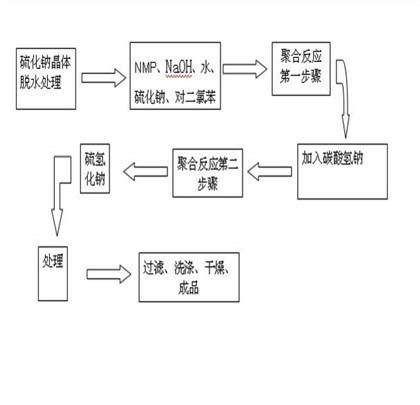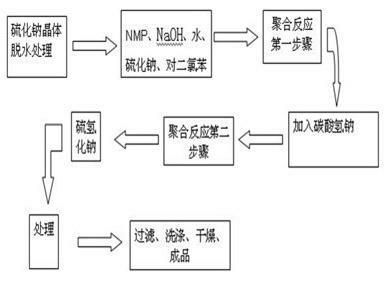Process for synthesizing low-chlorine film polyphenylene sulfide resin
A technology of polyphenylene sulfide resin and synthesis process, which is applied in the field of polymer material resin synthesis, can solve problems such as unseen process introduction, and achieve the effects of improving production efficiency, increasing reaction speed, and saving costs
- Summary
- Abstract
- Description
- Claims
- Application Information
AI Technical Summary
Problems solved by technology
Method used
Image
Examples
Embodiment 1
[0024] In a 1L dehydration kettle, add sodium sulfide (Na 2 S.5H 2 O) 2.0mol, under the protection of 99.99% nitrogen, heat the temperature to 120°C, and then vacuumize and dehydrate under the condition of maintaining the temperature and pressure at -0.3Mpa, so that the moles of sodium sulfide and water in the sodium sulfide solution The ratio becomes 1:1.2, then use the 4.5mol / molNa 2 The NMP solvent of S is added from the top of the dehydration column of the molecular sieve, directly flows into the 2L high-pressure reactor, and then NaOH is added to the reactor with a molar mass of 0.1mol / molNa 2 S, after raising the temperature to 130°C, add 2mol of p-dichlorobenzene. Then replace the air in the reactor with nitrogen 3-5 times, then seal the reactor, the temperature rises to 238°C, and keeps at this temperature for 2h, and when the temperature drops to 130°C, add 0.1mol / molNa 2 For the industrial grade sodium bicarbonate of S, the temperature rises to 238°C and is kept a...
Embodiment 2
[0026] In a 1L dehydration kettle, add sodium sulfide (Na 2 S.5H 2 O) 2.0mol, under the protection of 99.99% nitrogen, heat the temperature to 125°C, and then vacuumize and dehydrate under the condition of maintaining the temperature and pressure at -0.3Mpa, so that the moles of sodium sulfide and water in the sodium sulfide solution The ratio becomes 1:1.3, then use the 4.5mol / molNa 2 The NMP solvent of S is added from the top of the dehydration column of the molecular sieve, directly flows into the 2L high-pressure reactor, and then NaOH is added to the reactor with a molar mass of 0.2mol / molNa 2 S, after raising the temperature to 135°C, add 2 mol of p-dichlorobenzene. Then replace the air in the reactor with nitrogen 3-5 times, and then seal the reactor, the temperature rises to 240°C, and keeps at this temperature for 2.5h, and when the temperature drops to 135°C, add 0.04mol / molNa 2 For industrial grade sodium bicarbonate of S, the temperature rises to 240°C and is ke...
Embodiment 3
[0028] In a 1L dehydration kettle, add sodium sulfide (Na 2 S.5H 2 O) 2.0mol, under the protection of 99.99% nitrogen, heat the temperature to 130°C, and then vacuumize and dehydrate under the condition of maintaining the temperature and pressure at -0.3Mpa to make the molar ratio of sodium sulfide and water in the sodium sulfide solution becomes 1: 1.5, then use 4.5mol / molNa 2 The NMP solvent of S is added from the top of the dehydration column of the molecular sieve, directly flows into the 2L high-pressure reactor, and then NaOH is added to the reactor with a molar mass of 0.3mol / molNa 2 S, after raising the temperature to 140°C, add 2mol of p-dichlorobenzene. Then replace the air in the reactor with nitrogen 3-5 times, then seal the reactor, the temperature rises to 242°C, and keeps at this temperature for 3h, and when the temperature drops to 140°C, add 0.05mol / molNa 2 For industrial grade sodium bicarbonate of S, the temperature rises to 242°C, and after keeping at th...
PUM
| Property | Measurement | Unit |
|---|---|---|
| melting point | aaaaa | aaaaa |
| Ash content | aaaaa | aaaaa |
| molecular weight distribution | aaaaa | aaaaa |
Abstract
Description
Claims
Application Information
 Login to view more
Login to view more - R&D Engineer
- R&D Manager
- IP Professional
- Industry Leading Data Capabilities
- Powerful AI technology
- Patent DNA Extraction
Browse by: Latest US Patents, China's latest patents, Technical Efficacy Thesaurus, Application Domain, Technology Topic.
© 2024 PatSnap. All rights reserved.Legal|Privacy policy|Modern Slavery Act Transparency Statement|Sitemap


